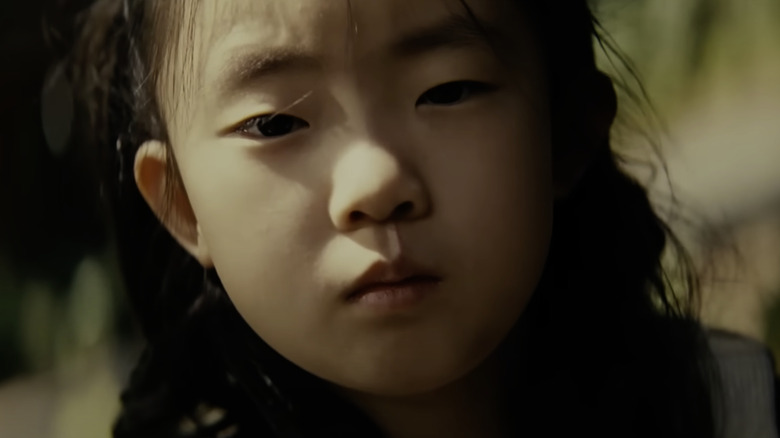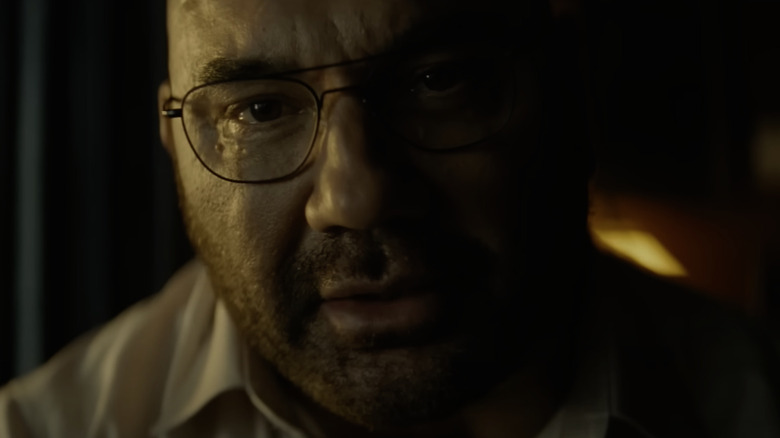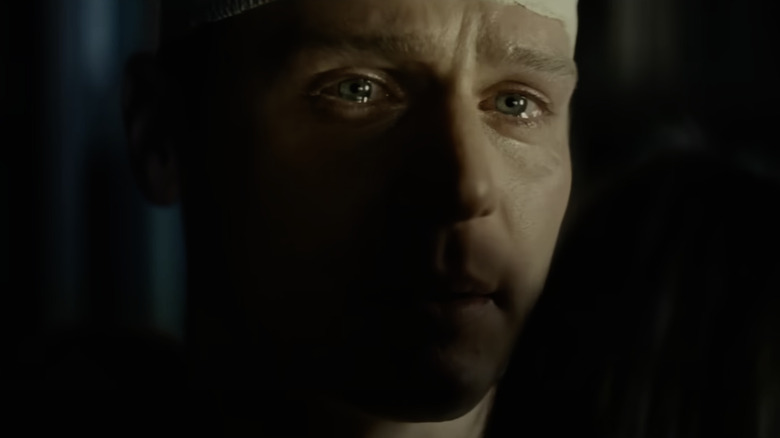M. Night Shyamalan Channelled Silence Of The Lambs Director Jonathan Demme For Knock At The Cabin
This article contains mild spoilers for "Knock at the Cabin."
If you haven't already, be sure to put on your boogie shoes and brace yourself for a signature M. Night Shyamalan thrill, because "Knock at the Cabin" is currently the number one movie at the domestic box office right now, and the divisive director has delivered yet another controversial but singular piece of cinema for movie fans to debate over.
As an adaptation of the novel, "The Cabin at the End of the World" by Paul Tremblay, the film impressively weaves the home invasion thriller with apocalyptic, existential dread. Two dads, Andrew (Ben Aldridge) and Eric (Jonathan Groff), and their daughter Wen (Kristen Cui) have their vacation forcefully interrupted by a group of four strangers bearing weapons. Leonard (Dave Bautista), the leader of the group, explains to the family that his pack of strangers are on a mission to save humanity — and in order to accomplish their goal, one member of their family unit must be sacrificed.
The film is far from a feel-good time at the movies, but the source material has a strong emotional center to it, making Shyamalan's bleak but sentimentalist style a perfect fit for the material (until it makes bold artistic diversions from its source). As polarizing as the film is, many critics agree that "Knock at the Cabin" is one of Shyamalan's most polished and technically inspired entries so far. The director successfully finds numerous ways to make the film's one location as dynamic as possible, and one particular technique that Shyamalan employs is borrowed directly from Jonathan Demme's horror classic, "Silence of the Lambs."
As you watch "Knock at the Cabin," pay attention to how Shyamalan directs his actors to look directly into the camera during particularly tense and extreme conversations.
More than a homage
But it's more than just a nice homage. M. Night Shyamalan's frequent use of extreme close-up gives his film a feeling of surreality and connects his characters together in exciting ways. The technique is first used in the opening scene between Wen and Leonard, in which they play a disarmingly ominous truth-telling game with each other that slowly reveals Leonard's intentions. As Andrew and Eric get trapped and tied up, intimate conversations between the two are also conveyed by the signature Demme eyelines.
The actor behind Andrew, Ben Aldridge, spoke to The Wrap about how challenging it was to accomplish these scenes from a practical, on-set perspective. "They're really hard for me. I'm like, 'Where's the other actor? Where are the eyes of the other actor' I don't feel as secure. I don't feel as tethered to the moment that I'm playing," Aldridge admitted. "Even if I can hear the person. I feel like it makes me feel a little bit at sea. Because you're usually informing each other. What you do is such a collaboration. But that was a new skill to get used to and he used that a lot in this at some emotionally explosive moments."
Shyamalan's films, although visually polished, are usually slightly stilted in dialogue and in performances. Though Aldridge opened up about his unease and feeling of detachment — it's just as likely that is just the reaction Shyamalan is provoking. There's a rift between Andrew and Eric that slowly divides the couple throughout "Knock of the Cabin." Especially as Andrew, the more cynical and logical-minded of the couple, continues to resist that his captors are telling the truth about their motivations.
A clever technical trick helped preserve emotional authenticity
Sparing the rest of the details, Eric's more emotional, optimistic mind starts to see visions — and it all culminates in one pivotal conversation that will determine the fate of humanity. In the final scene between Andrew and Eric, Shyamalan once again decides to revert back to an extreme close-up, admiring the eyes of his two protagonists.
To achieve as much raw emotion as possible, the crew came up with a clever technical solution to compromise for the actors not being able to directly look into each other's eyes and bounce off of one another. Here's what Ben Aldridge told The Wrap:
"The final scene that we did, he decided to play to camera and he had this special device that is kind of like what we're using now, the teleprompter. It's a mirror. Somehow they overlaid via a mirror, the image of Jonathan's face over the lens. So we're acting in real-time. Even though Jonathan was to the side of the camera, I was still looking into his eyes, which, I'm so glad he did that, because I think that scene would have been extra challenging if we hadn't had that device."
Love or hate Shyamalan, the self-funded projects that define the latest stage of his career are exciting events for film lovers. The mid-budget movie seems to be a disappearing breed these days, but the producer/director is single-handedly keeping them alive with a genuine style to match.
"Knock at the Cabin" is in theaters now.


